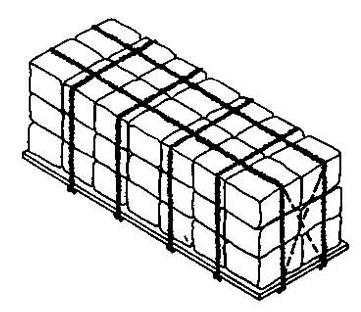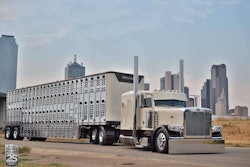 ATA’s Agricultural and Food Transporters Conference is petitioning FMCSA for an exemption from securement regulations to allow certain agriculture commodities haulers to secure loads differently from what is allowed by current regulations.
ATA’s Agricultural and Food Transporters Conference is petitioning FMCSA for an exemption from securement regulations to allow certain agriculture commodities haulers to secure loads differently from what is allowed by current regulations.The American Trucking Associations’ Agricultural and Food Transporters Conference has requested an exemption from cargo securement regulations for certain agricultural commodities to allow what it says are safer securement methods.
AFTC in its exemption application states there are no commodity-specific tie-down rules for agricultural commodities transported in wood and plastic boxes and large fiberglass tubs, or for hay, straw and cotton bales that are grouped into large singular units. Because there are no specific rules for these products, haulers have to comply with FMCSA’s general cargo securement requirements.
The group adds that ag haulers in California have been operating under an exemption granted by the California Highway Patrol that allows alternate securement methods because the general federal cargo securement requirements “resulted in a less secure agricultural commodity cargo securement environment,” AFTC says in its request.
AFTC is proposing alternate securement methods for boxes, bins and tubs during the transportation of agricultural products from the field or storage to the first point of processing and the return of empty containers to the field or storage location.
For wood and plastic boxes and bins, AFTC proposes they should be secured by perimeter tie-downs used in pairs with corner irons, along with blocking at the front end of the trailer. Trailers 32 feet long or less would also require the use of at least one lateral tie-down in the center of the trailer, AFTC proposes. Trailers longer than 32 feet would require at least two lateral tie-downs.
The group proposes that fiberglass tubs be secured with at least two perimeter tie-downs – one attached near the front right corner of the trailer crossing diagonally to the left rear corner of the tub, and one attached near the front left corner of the trailer and extending to the right rear corner of the tub.
Finally, for baled cotton, hay, straw and other similar commodities in horizontal bales would have to be secured with at least two parallel longitudinal tie-downs over the top of the load and by at least four cross tie-downs if loaded more than one tier high. Vertical bales would have to be secured with two perimeter tie-downs. If stacked in two tiers, the group proposes two longitudinal tie-downs that extend over the top of the load and at least four cross tie-downs.
If granted, the exemption would apply to truckers nationwide hauling freight that meets the requirements for the exemption.
The Federal Motor Carrier Safety Administration is seeking public comment on AFTC’s exemption request, which can be made here through Feb. 5.












